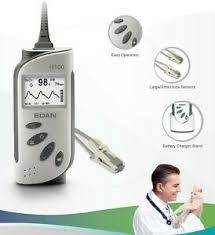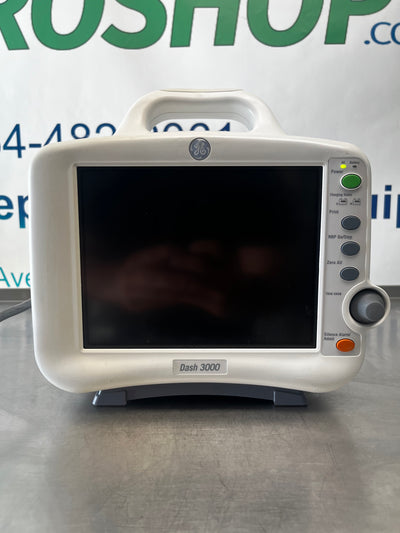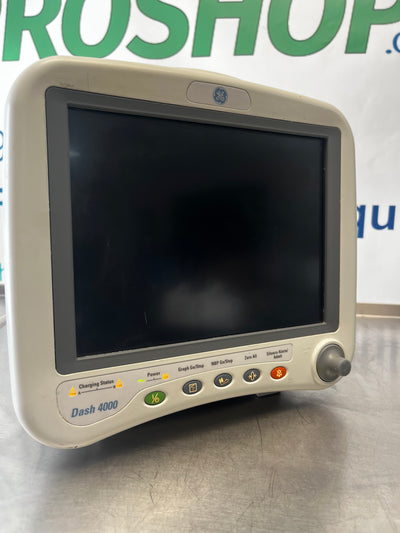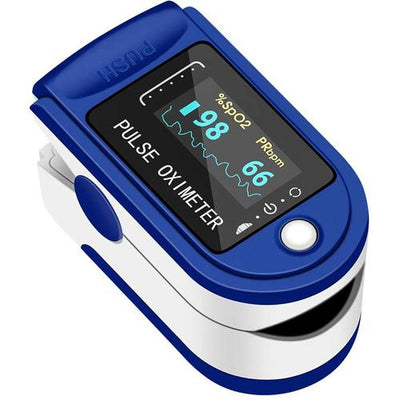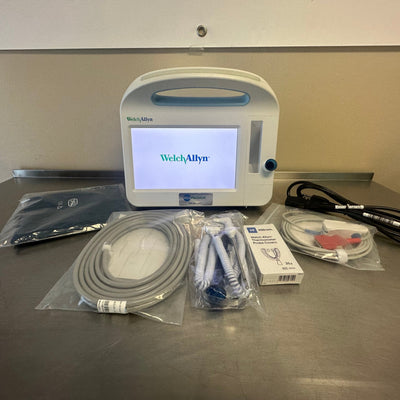Pulse Oximiters
Pulse oximetry is a noninvasive method for monitoring a person's oxygen saturation. Peripheral oxygen saturation (SpO2) readings are typically within 2% accuracy (within 4% accuracy in the worst 5% of cases) of the more desirable (and invasive) reading of arterial oxygen saturation (SaO2) from arterial blood gas analysis. But the two are correlated well enough that the safe, convenient, noninvasive, inexpensive pulse oximetry method is valuable for measuring oxygen saturation in clinical use.
The most common approach is transmissive pulse oximetry. In this approach, a sensor device is placed on a thin part of the patient's body, usually a fingertip or earlobe, or an infant's foot. Fingertips and earlobes have higher blood flow rates than other tissues, which facilitates heat transfer. The device passes two wavelengths of light through the body part to a photodetector. It measures the changing absorbance at each of the wavelengths, allowing it to determine the absorbances due to the pulsing arterial blood alone, excluding venous blood, skin, bone, muscle, fat, and (in most cases) nail polish.
Wikimedia Foundation. (2021, August 8). Pulse oximetry. Wikipedia. https://en.wikipedia.org/wiki/Pulse_oximetry.
Description:
The H100B Pulse Oximeter provides a simple universal tool for monitoring; from spot checks to continuous monitoring. All monitoring data can be transferred to PC for storage, management, review and printing.
Features:
- FDA Approved
- LCD display
- RTC (Real Time Clock) display
- Backlight control and automatic power-off function for power saving
- SpO2 and Pulse rate measurement
- Display numeric and waveform of SpO2 simultaneously
- Long battery life - up to 48 hours on 4 “AA” or 36 hours on Ni-MH rechargeable batteries
- Powerful data storage capacity
- Data can be transferred to PC for storage, review and printing
If you require further information, please feel free to call us at: (954) 482-2061
Description:
The H100B Pulse Oximeter provides a simple universal tool for monitoring; from spot checks to continuous monitoring. All monitoring data can be transferred to PC for storage, management, review and printing.
Features:
- FDA Approved
- LCD display
- RTC (Real Time Clock) display
- Backlight control and automatic power-off function for power saving
- SpO2 and Pulse rate measurement
- Display numeric and waveform of SpO2 simultaneously
- Long battery life - up to 48 hours on 4 “AA” or 36 hours on Ni-MH rechargeable batteries
- Powerful data storage capacity
- Data can be transferred to PC for storage, review and printing
If you require further information, please feel free to call us at: (954) 482-2061
GE Dash 3000 Monitor
-
Networking options for both wired and wireless.
-
3 to 6 waveform and up to 4 pressure can be views at once.
-
4-5 hours of running battery time.
-
Multi-lead ECG analysis and DINAMAP NIBP technology all in one monitor.
-
seamless Patient Data transfer to Facilities computer system.
If you require further information, please feel free to call us at: (954) 482-2061
GE Dash 3000 Monitor
-
Networking options for both wired and wireless.
-
3 to 6 waveform and up to 4 pressure can be views at once.
-
4-5 hours of running battery time.
-
Multi-lead ECG analysis and DINAMAP NIBP technology all in one monitor.
-
seamless Patient Data transfer to Facilities computer system.
If you require further information, please feel free to call us at: (954) 482-2061
Description
The GE DASH 4000 Patient Monitor is one of the most advanced Monitors available for clinicians who want to improve the quality of their care. DASH monitors feature ECG, NIBP, SP02, and other leading patient-safety enhancements in a rugged, ergonomic design light and durable enough to handle even air transport. Modular enhancements and a large 10.4″ color display make the GE Dash 4000 a good fit for the ER, Surgical Center and even the ICU. No Patient Monitor on the market offers more life-saving assessment tools like 12-lead 12SL, EK-Pro arrhythmia, ST segment analysis, A-Fib detection and IntelliRate alarm reduction for less cost. GE bedside monitors feature a common Trim Knob user interface and intuitive menu structures, so every clinician can be skilled using the bedside monitor throughout your continuum of care.
Multiple mounting solutions and a wide range of accessories ensure easy and flexible workplace configuration so caregivers can adapt to each patient’s monitoring needs. DASH Patient Monitors are designed for integration into commonly utilized existing wireless networks, helping you leverage your investment in your current IT infrastructure. Advanced clinical parameters including 12SL™ for simultaneous ECG monitoring, GE EK-Pro™ for multi-lead arrhythmia analysis, ICG, mainstream and side stream CO2 and GE DINAMAP® NIBP with Super STAT™. Networking options include wired and wireless Up to 7 waveforms and up to 4 invasive pressures High resolution CRG trends for NICU monitoring.
The GE DASH monitoring family is a portable monitoring system that is flexible and easy to use. DASH allows the acuity of any bed to be modified to meet changing patient needs.
Dash monitors revolutionize patient care and assessment by combining the most complete selection of gold standard patient monitoring parameters with leading-edge cardiac technology. The GE DASH monitoring family is a portable monitoring system that is flexible and easy to use. Dash allows the acuity of any bed to be modified to meet changing patient needs. DASH monitors revolutionize patient care and assessment by combining the most complete selection of gold standard patient monitoring parameters with leading-edge cardiac technology.
The unit Is in working condition. Ready to be shipped.
Description
The GE DASH 4000 Patient Monitor is one of the most advanced Monitors available for clinicians who want to improve the quality of their care. DASH monitors feature ECG, NIBP, SP02, and other leading patient-safety enhancements in a rugged, ergonomic design light and durable enough to handle even air transport. Modular enhancements and a large 10.4″ color display make the GE Dash 4000 a good fit for the ER, Surgical Center and even the ICU. No Patient Monitor on the market offers more life-saving assessment tools like 12-lead 12SL, EK-Pro arrhythmia, ST segment analysis, A-Fib detection and IntelliRate alarm reduction for less cost. GE bedside monitors feature a common Trim Knob user interface and intuitive menu structures, so every clinician can be skilled using the bedside monitor throughout your continuum of care.
Multiple mounting solutions and a wide range of accessories ensure easy and flexible workplace configuration so caregivers can adapt to each patient’s monitoring needs. DASH Patient Monitors are designed for integration into commonly utilized existing wireless networks, helping you leverage your investment in your current IT infrastructure. Advanced clinical parameters including 12SL™ for simultaneous ECG monitoring, GE EK-Pro™ for multi-lead arrhythmia analysis, ICG, mainstream and side stream CO2 and GE DINAMAP® NIBP with Super STAT™. Networking options include wired and wireless Up to 7 waveforms and up to 4 invasive pressures High resolution CRG trends for NICU monitoring.
The GE DASH monitoring family is a portable monitoring system that is flexible and easy to use. DASH allows the acuity of any bed to be modified to meet changing patient needs.
Dash monitors revolutionize patient care and assessment by combining the most complete selection of gold standard patient monitoring parameters with leading-edge cardiac technology. The GE DASH monitoring family is a portable monitoring system that is flexible and easy to use. Dash allows the acuity of any bed to be modified to meet changing patient needs. DASH monitors revolutionize patient care and assessment by combining the most complete selection of gold standard patient monitoring parameters with leading-edge cardiac technology.
The unit Is in working condition. Ready to be shipped.
This fingertip pulse oximeter measures heart rate and oxygen saturation.
For medical and home use. This is a noninvasive and painless test that measures your oxygen saturation level, or the oxygen levels in your blood. It can rapidly detect even small changes in how efficiently oxygen is being carried to the extremities furthest from the heart, including the legs and the arms.
Covid 19 relief package, we sell sanitizer wipes, hand sanitizer, sanitizer and soap dispensers, KN95 masks, and more!
Items are sold separately.
If you require further information, please feel free to call us at: (954) 482-2061
This fingertip pulse oximeter measures heart rate and oxygen saturation.
For medical and home use. This is a noninvasive and painless test that measures your oxygen saturation level, or the oxygen levels in your blood. It can rapidly detect even small changes in how efficiently oxygen is being carried to the extremities furthest from the heart, including the legs and the arms.
Covid 19 relief package, we sell sanitizer wipes, hand sanitizer, sanitizer and soap dispensers, KN95 masks, and more!
Items are sold separately.
If you require further information, please feel free to call us at: (954) 482-2061
Refurbished
Refurbished
Welch Allyn Connex 6000 Series comes with a mobile stand and features an easy-to-use, touchscreen monitor that displays Pulse Ox, NIBP, and Temp.
The Welch Allyn Connex mobile stand features an integrated work light and bins for all necessary accessories.
If you require any further information, please feel free to call us at: (954) 482-2061
Welch Allyn Connex 6000 Series comes with a mobile stand and features an easy-to-use, touchscreen monitor that displays Pulse Ox, NIBP, and Temp.
The Welch Allyn Connex mobile stand features an integrated work light and bins for all necessary accessories.
If you require any further information, please feel free to call us at: (954) 482-2061

